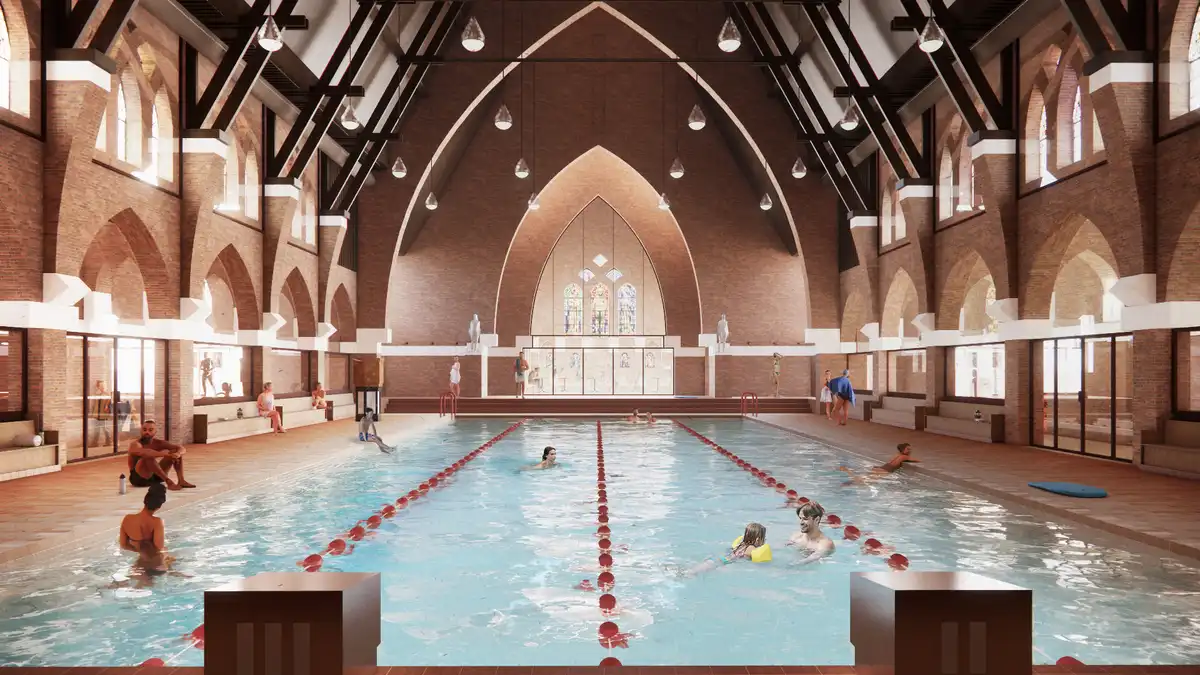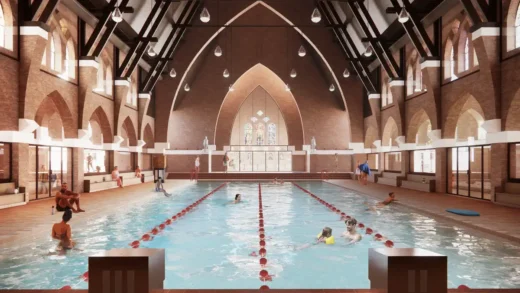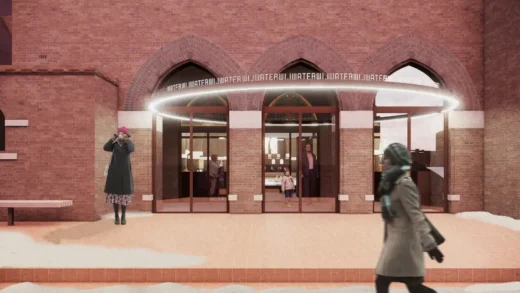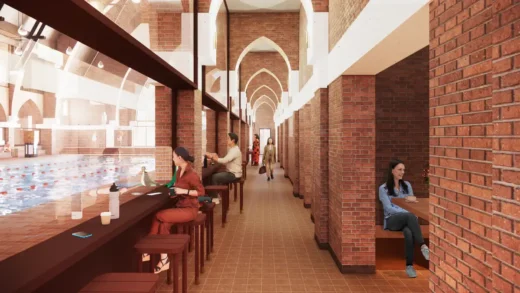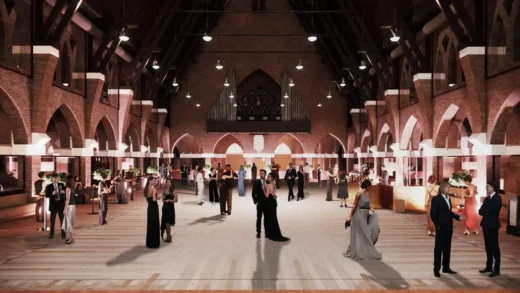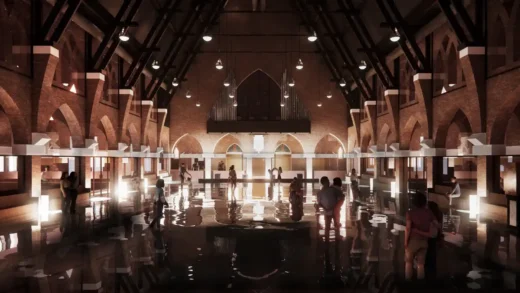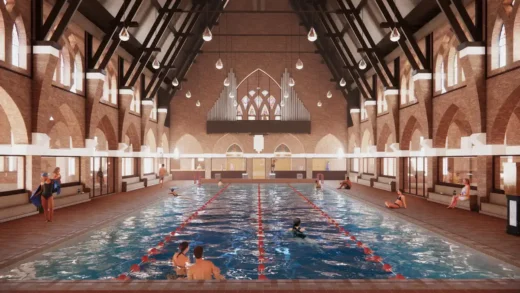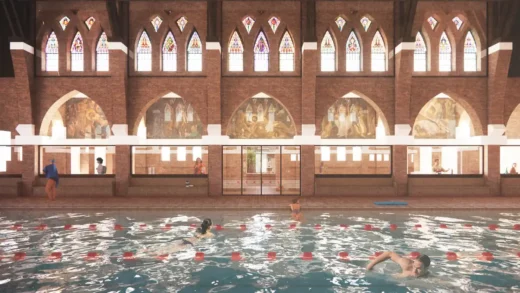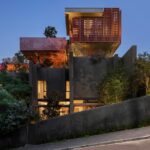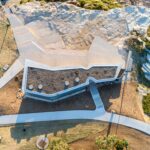Heerlen Holy Water Public Swimming Pool Limburg building, Dutch architecture images, Holland leisure
Heerlen Holy Water Public Swimming Pool in Limburg, Holland
17 April 2025
Design: MVRDV and Zecc
Location: Heerlen, Limburg, North Brabant, Holland, The Netherlands
Images © MVRDV, Zecc Architecten
Heerlen Holy Water, Holland
MVRDV and Zecc to transform vacant church into public swimming pool in Heerlen, the Netherlands
MVRDV and Zecc Architecten have won the competition for the transformation of the St. Francis of Assisi Church in Heerlen into a public swimming pool. Nicknamed Holy Water, the transformation gives the vacant church a new, social function, while preserving the historic elements of this listed national monument. An adjustable swimming pool floor brings flexibility to the space that was once the church’s nave, allowing it to host a variety of activities in addition to swimming. The floor also makes it possible to fill the entire space with a thin layer of water, creating an impressive reflection of the church that gives visitors the feeling that they can walk on water.
Originally built over 100 years ago, the St. Francis of Assisi Church in Heerlen, in the south of the Netherlands, stopped hosting services in 2023, providing the municipality the opportunity to find another purpose for the building. A new pool in this national monument offers a solution for the increasing number of visitors to Heerlen’s existing pools, while giving the vacant building with its recognisable silhouette in the city centre a new lease of life. The transformation of the church fits within the larger city centre development, which includes the arrival of a Roman museum and the renovation of the Royal-Rivoli cinema.
In the design, an illuminated circular canopy marks the main entrance, providing a reference to the church’s past and a contemporary addition that connects old and new. Once inside, visitors can proceed through the church’s aisles to reach the changing rooms or the catering facility, both located at the rear of the church. Glass walls separate these passages from the climatised central pool space.
To make room for the swimming pool, the existing floor will be carefully removed. The church’s pews will be reused by incorporating them into the separating glass walls surrounding the pool, providing seats for the swimmers on one side, while serving as bar tables for spectators on the other side. The old pulpit is given a new function, serving as the seat for a lifeguard.
The pool floor has an adjustable bottom that can be raised and lowered, enabling different activities for swimmers of different ages and abilities. In its extreme position, the floor can be raised completely, hiding the pool beneath and reintroducing a completely flat floor so that the space can also be used for social and cultural activities. In addition, the entire pool area can be filled with a shallow layer of water. Combined with the right lighting, the church interior will be reflected in this shallow pool, and visitors will be able to “walk on water” inside the church.
“The vacancy rate of churches is increasing, so we need to come up with new, creative ideas for what we can do with these buildings”, says Winy Maas, founding partner of MVRDV. “Why not give these churches a social function again, as they used to have? A public swimming pool is ideally suited for this. Imagine: swimming the backstroke with a view of a church vault and stained-glass windows. By covering the entire pool area with a small layer of water, you can also create a beautiful visual effect, allowing the church to return to its original form and appear even larger and more impressive through the reflection.”
A new mosaic floor will adorn both the pool surroundings and the adjustable pool floor. This will reference the existing colours, materials, and stained-glass windows of the church. The design for this floor will be made in collaboration with local artists as a reference to the many murals that Heerlen has to offer. The lighting above the pool is inspired by the original church lamps seen in historic photographs, with the four rows of lamps doubling as lane guides for the swimmers.
A particular challenge of the design was to be able to heat the pool space sufficiently and sustainably, while also protecting the historic materials from the humidity of the pool. To solve this, the glass walls surrounding the pool create a compartmentalising effect to protect the stained glass and the works of art. The roof of the church will be insulated from the outside, preventing excessive heat loss while maintaining the view of the original brickwork from the inside. After insulation, the existing roof covering will be put back in place. The wooden roof will be retained and fitted with sound-absorbing panels for better acoustics. The technical installations have been discreetly incorporated with air handling units in the basement. This approach ensures an energy-efficient and comfortable indoor climate, while preserving the historical elements of the church as much as possible.
The design for Holy Water was created through a collaboration between MVRDV, Zecc Architecten, IMd Raadgevende Ingenieurs, Nelissen Ingenieursbureau and construction economics consultancy SkaaL. The first dive is expected to take place at the end of 2027.
Dutch Mining Museum in Limburg, The Netherlands – Building Information
Design: MVRDV – https://www.mvrdv.com/ and Zecc – https://www.zecc.nl/en/
About MVRDV:
Architecture practice MVRDV was set up in 1993 in Rotterdam, the Netherlands by Winy Maas, Jacob van Rijs, and Nathalie de Vries. Finding early success with projects such as the headquarters for the Dutch Public Broadcaster VPRO and WoZoCo housing for the elderly in Amsterdam, MVRDV developed into an internationally renowned firm. Now, the three founding partners lead a dynamic and optimistic team of over 300 alongside partners Frans de Witte, Fokke Moerel, Wenchian Shi, Jan Knikker, and Bertrand Schippan. With four satellite offices in Shanghai, Paris, Berlin, and New York, MVRDV engages globally in providing solutions to contemporary architectural and urban issues.
MVRDV operates via a research-based and highly collaborative design method, engaging experts from all fields, clients, and stakeholders in their rigorous technical and creative investigation. This results in exemplary and outspoken buildings, urban plans, studies, and objects that enable our cities and landscapes to develop towards a better future. MVRDV works with BIM and has official in-house BREEAM and LEED assessors. Together with Delft University of Technology, MVRDV runs The Why Factory, an independent think tank and research institute providing an agenda for architecture and urbanism by envisioning the city of the future.
Renders © MVRDV, Zecc Architecten
Heerlen Holy Water Public Swimming Pool in Limburg, Holland images / information received 170425
Location: Heerlen, Limburg, North Brabant, The Netherlands, western Europe
Limburg Buildings
Contemporary Limburg Architectural Designs
Julianaplein Vaals
Design: Martens Willems & Humblé Architecten
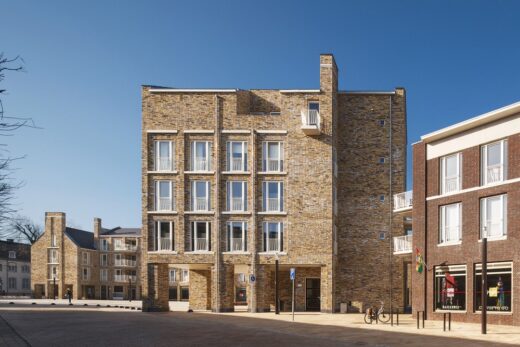
photo : Arjen Schmitz
Julianaplein Vaals, Limburg, North Brabant
Les Mouleurs, Maastricht
Design: Martens Willems & Humblé Architecten
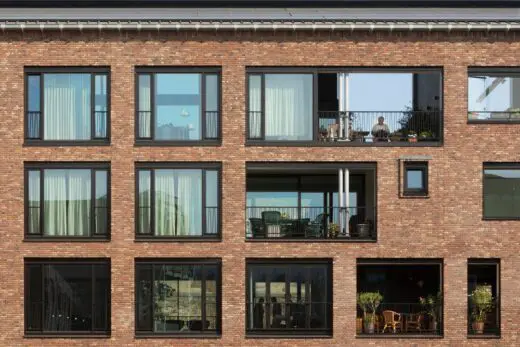
photo : Arjen Schmitz
Les Mouleurs, Maastricht Housing
Canon Production Printing HQ, Venlo
Design: M+R interior architecture

photo : Herman de Winter
Canon Production Printing HQ, Venlo, NL
Architecture in The Netherlands
Contemporary Dutch Architecture
Netherlands Architecture Designs – chronological list
Dutch Architecture Walking Tours by e-architect in Amsterdam (& Rotterdam)
Villa 1, Veluwe Zoom
Design: Powerhouse Company Architects
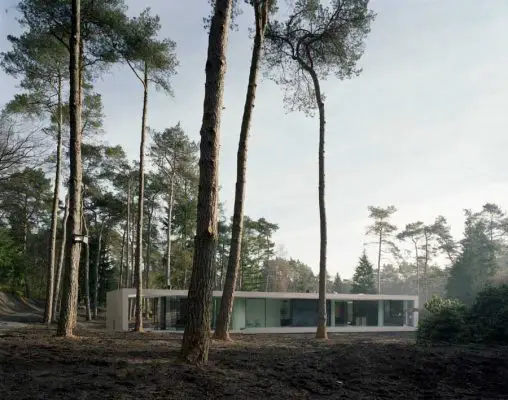
photograph : Bas Princen
Veluwe Zoom Villa
House IV
Design: De Bever Architecten

photo : Norbert van Onna
Eindhoven House
Dutch Architect – design firm listings
Comments / photos for the Heerlen Holy Water Public Swimming Pool in Limburg, Holland Architecture design by MVRDV page welcome

